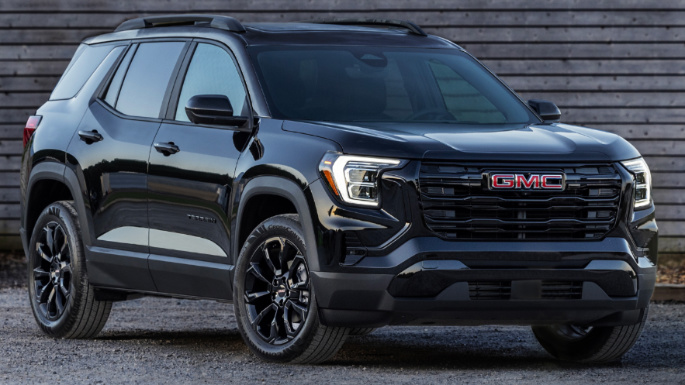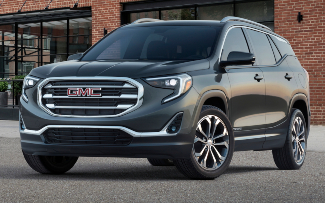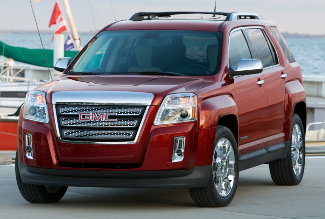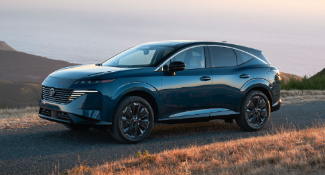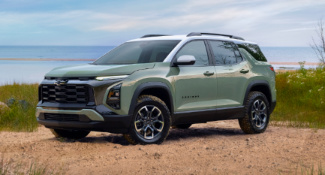Top Questions About the GMC Terrain:
1. Is GMC Terrain a good car?
The GMC Terrain is generally considered a good compact SUV, particularly for those who value comfort and a smooth ride. It offers a stylish design, a comfortable and quiet cabin, and a decent list of standard features, including advanced driver assistance systems. The Terrain also provides a good balance of performance and fuel efficiency, especially with its turbocharged engine options. However, it competes in a crowded segment with strong rivals, so it may not stand out in areas like handling or interior quality.
2. What are the disadvantages of a GMC Terrain?
Some disadvantages of the GMC Terrain include:
- Performance: While the Terrain offers a comfortable ride, it is not particularly sporty, and some drivers may find the handling less responsive compared to competitors like the Mazda CX-5 or Honda CR-V.
- Interior Quality: Although the interior is well-designed, some materials feel less premium than those in rival SUVs, especially in the lower trims.
- Cargo Space: The Terrain’s cargo space is adequate but not as generous as some competitors, which might be a drawback for families or those needing to transport larger items.
- Price: The Terrain can be more expensive than some of its competitors, especially when optioned with higher trims or additional features, which may not always justify the cost given the available alternatives.
3. Which is better, GMC Acadia or Terrain?
Choosing between the GMC Acadia and Terrain depends on your specific needs:
- GMC Acadia: The Acadia is a midsize SUV, offering more space, including a third row of seating, which makes it better suited for larger families or those who need extra passenger capacity. It also has more powerful engine options, which can be beneficial if you need more towing capacity or prefer a more robust driving experience.
- GMC Terrain: The Terrain is a compact SUV, which makes it more maneuverable and easier to park, particularly in urban environments. It’s also more fuel-efficient and generally costs less than the Acadia. If you don’t need the extra space or power, the Terrain might be the better, more economical choice.
- Ultimately, if you prioritize space and power, the Acadia is likely the better option. If you prefer a smaller, more efficient vehicle, the Terrain may be more suitable.
4. Which is better, Terrain or Equinox?
The GMC Terrain and Chevrolet Equinox are closely related, as they share the same platform and many components, but there are some differences:
- Design and Features: The Terrain is generally positioned as a more upscale option compared to the Equinox, with a slightly more premium interior and more advanced features available in higher trims.
- Price: The Equinox tends to be more affordable than the Terrain, offering similar performance and practicality at a lower cost, which can make it a better value for budget-conscious buyers.
- Brand Preference: Some buyers may prefer the GMC brand for its more premium image, while others may be more attracted to the Chevrolet brand, which offers a broader range of models and typically has more competitive pricing.
- In summary, if you’re looking for a more budget-friendly option with similar capabilities, the Equinox might be the better choice. If you prefer a slightly more premium feel and are willing to pay a bit more, the Terrain could be the way to go.
The GMC Terrain was the brand’s first compact crossover SUV. It represented another departure for General Motors’ truck division — three years after the three-row Acadia crossover debuted — into one that was increasingly consumer-focused rather than serious pickup truck users. Brand loyalists may have bemoaned the decision at the time, but GMC went from being a mere clone of Chevrolet trucks to establishing itself as a more premium truck and SUV brand just as the demand for such vehicles exploded in the 2010s, and the Terrain helped cement GMC’s place.
Since its introduction for the 2010 model year, the Terrain has been GMC’s smallest SUV and is closely related to the Chevy Equinox. There have been three generations of the Terrain.
2025 - Present GMC Terrain (3rd Generation)
The Terrain was redesigned for the 2025 model year, following the redesigned gasoline-powered Chevy Equinox. It was now based on GM’s highly modular light-duty vehicle platform that would be the basis for small sedans sold in China to pickup trucks like the GMC Canyon.
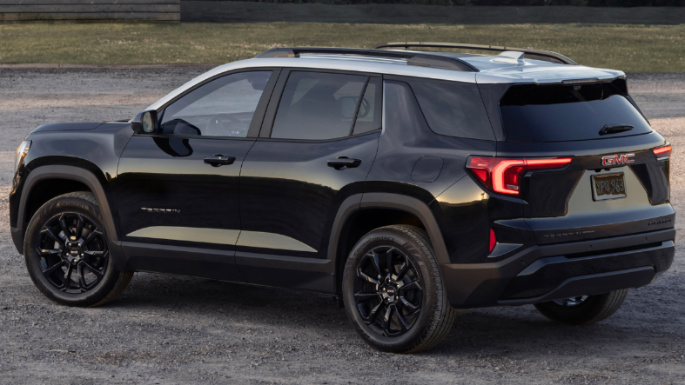
However, the Terrain grew slightly from the previous generation model but was still similar in size to models such as the Honda CR-V and Toyota RAV4. And like the previous Terrain, base versions aspired to mainstream compact crossovers while high-end versions aimed at aspirational compact SUVs such as the Jeep Compass Trailhawk, Acura RDX, and Lincoln Corsair.
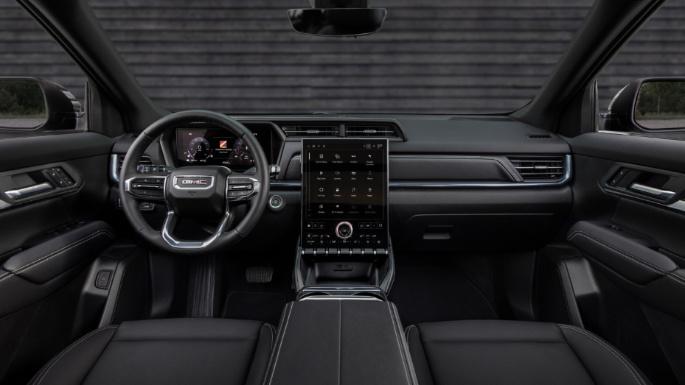
All Terrains used the carryover 175-horsepower, 1.5-liter turbocharged four-cylinder as in the last models of the previous generation and standard front-wheel-drive on all models except for the off-road-oriented AT4. Base models used a continuously variable transmission (CVT), while a new eight-speed automatic transmission was standard across the rest of the line. As before, only the AT4 model received more ground clearance, upgraded suspension, and a Terrain drive mode selection specifically for rougher surfaces.
The new base model, the Elevation, included features such as a heated steering wheel and heated front seats, automatic climate control, and automatic emergency braking with pedestrian and bicycle detection — some of which were optional on the Equinox. A new 15-inch, portrait-style touchscreen infotainment system joined an 11-inch digital instrument panel on all models.
The Terrain Denali, which like the AT4 was labeled a 2026 model, continued with its distinctive grille, wheel, and exterior package along with upgraded interior materials, and a revised suspension for improved comfort.
2018 - 2024 GMC Terrain (2nd Generation)
The second-generation GMC Terrain debuted in 2018. To build on the success of the GMC brand, the new Terrain and Equinox were completely redesigned in a direct attack on the best-selling compact SUVs, while also breaking away from each other as that class of vehicle exploded in popularity and buyers demanded more features and comfort.
This new model shrank by just over three inches in overall length and shed roughly 400 pounds over the outgoing model. Those changes allowed it to compete more directly with other compact SUVs and distanced it more from the second-generation Acadia, which was also made smaller to align itself better with midsize SUVs.
Another noticeable change with the Terrain’s newly slimmed profile was a sleeker design than the first-generation’s block-like shape, including a more curved grille that wasn’t trying to pretend to be lifted off of a Yukon or Sierra. The interior design was also more contemporary with a better-integrated infotainment system and a new (and divisive) push-button gear selector that differed from Equinox’s setup.
The base SL trim comes with standard features that include keyless access and start, a rear-view camera, a leather-wrapped steering wheel, 17-inch alloy wheels, two USB ports at the front seats and two USB ports in the rear seat, a seven-inch touchscreen infotainment system with Apple CarPlay and Android Auto compatibility, Bluetooth connectivity. SLE models gained access to features such as dual-zone automatic climate control, blind-spot monitoring, and rear cross-traffic alert, while SLT added automatic emergency braking, high-beam assist, and a power liftgate.
High-trim Denali models also returned with a distinctive grille, larger and brighter wheels, monochromatic exterior trim, and upscale features such as heated leather seats inside and just about every option available on the other trims.
The SL is powered by a turbocharged 1.5-liter, four-cylinder engine with 170 hp output and 203 pound-feet torque. It's paired with a nine-speed automatic transmission on standard front-wheel-drive models and buyers can add optional trailer abilities.
The SLE trim adds options like an auto-dimming rear-view mirror, interior upgrades, and the availability of several additional option packages. The Driver Convenience package includes heated front seats, a power-adjustable driver seat, remote engine start, and dual-zone automatic climate control. The Driver Alert I package includes rear cross-traffic alert, heated mirrors, rear parking sensors, and blind-spot monitoring. There's also an additional Infotainment package.
The SLT trim comes with the Driver Convenience and Infotainment I packages as well as leather upholstery. You can choose to upgrade to the Infotainment II, Driver Alert I, or Driver Alert II packages which add on automatic braking, automatic high beams, and lane departure warning. The Preferred package then includes a power passenger seat, a heated steering wheel, driver-seat memory settings, and a power lift-gate.
A turbocharged 1.5-liter four-cylinder engine with 170 horsepower was the base engine for all but the Denali. That model received a larger 2.0-liter turbo four-cylinder with 252 horsepower, which was optional on the SLE and SLT. Front-wheel drive and a nine-speed automatic transmission were standard, while all-wheel drive was available on all but the SL.
A new engine, however, came in the form of a 1.6-liter turbodiesel four-cylinder with 137 horsepower and the promise of nearly 40 mpg on the highway. It was an option for SLE and SLT models.
A 360-degree camera was a new option on Denali trim models in 2019 and a Black Edition appearance package was available on the SLE and SLT. Driver assistance systems such as automatic emergency braking, lane-keep assist, and automatic high-beam assist were made standard on all Terrains for 2020, but the diesel engine was dropped due to lack of demand.
The Terrain received a modest facelift for 2022 that consisted mostly of redesigned lights, bumpers, and wheels across the lineup. The base SL was dropped, but the off-road-oriented AT4 was added to the lineup. The 2.0-liter turbo was also eliminated across the board, meaning all models used the 1.5-liter turbo engine.
That sole remaining engine gained five horsepower for 2023, but that was it for the second generation as a new Terrain debuted in 2025.
2010 - 2017 GMC Terrain (1st Generation)
The GMC Terrain was introduced for the 2010 model year. In essence, it served two purposes: one, to add a smaller SUV below the highly successful Acadia midsize SUV introduced three years earlier. And, two, as a replacement for the Pontiac Torrent, which was discontinued following that brand’s demise after 2009, and as many Pontiac dealers also marketed GMC products.
Like the old Torrent, the Terrain was a version of the Chevy Equinox, itself redesigned for 2010. Both used an 182-horsepower, 2.4-liter four-cylinder as a standard engine with an optional 264-horsepower, 3.0-liter V6. Front-wheel-drive was standard with all-wheel drive an option, and all models used a six-speed automatic transmission.
While the interior was largely identical to the Equinox’s, the Torrent’s exterior styling was modified more significantly than the Chevy’s with a prominent grille that looked like it was ripped off of the Yukon and an overall squarer shape that tried to hide its car-based roots. Like the Equinox, though, the Terrain was slightly larger than compact SUV rivals like the Ford Escape and Nissan Rogue, which gave it advantages such as room for that optional V6 and a sliding rear-seat bench.
There were four trim levels: SLE-1, SLE-2, SLT-1 and SLT-2. SLE came with 17-inch alloy wheels, a tilt-telescoping steering wheel, power accessories, heated exterior mirrors, and GM’s OnStar telematics system, while the SLE-2 added niceties such as a power driver’s seat, Bluetooth connectivity, and automatic climate control. SLT models generally included leather upholstery, heated front seats, and remote engine start, while options included a power liftgate, sunroof, and larger wheels.
Few changes were made to the popular Terrain for 2011 and 2012. In 2013, GMC introduced the Denali trim to the model with satin chrome accents and a distinctive grille as seen on the Acadia and Yukon Denali models, as well as upgraded interior trim. All models were now available with a larger V6 in place of the underpowered 3.0-liter, with a 3.6-liter V6 with 301 horsepower taking its place. A new base SL model with front-wheel-drive and four-cylinder engine only joined the lineup in 2015.
The Terrain received a modest facelift for the 2016 model year with subtle front and rear styling revisions, a new hood, and new wheel designs. There were also some changes to interior controls. However, other than some Nightfall appearance packages in 2017, the first-generation proved successful enough to warrant a redesign for the 2018 model year.
